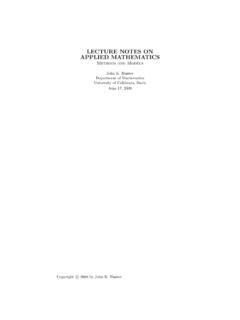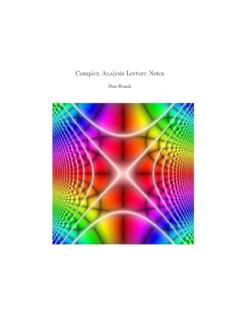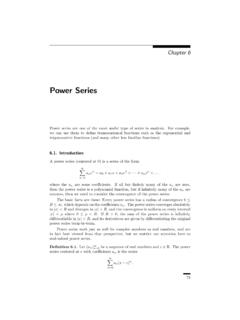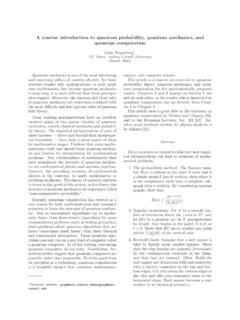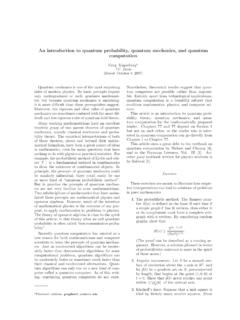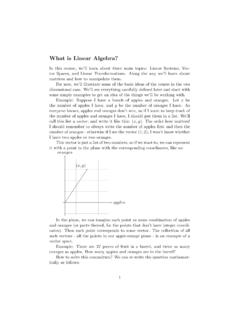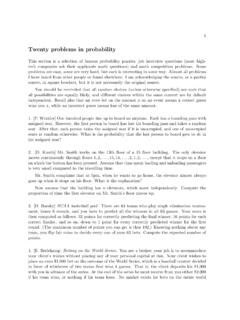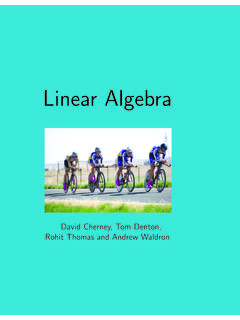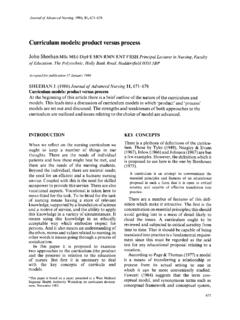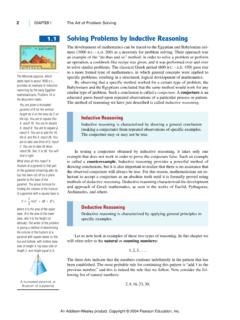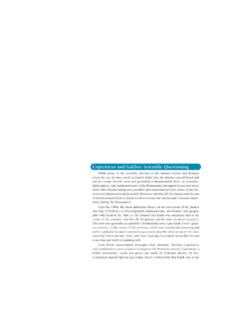Transcription of History of calculus - Mathematics Home :: math.ucdavis.edu
1 1/1/10 5:02 PMHistory of calculus - Wikipedia, the free encyclopediaPage 1 of 19 of calculusHistory of scienceBackgroundTheories/sociologyHisto riographyPseudoscienceBy eraIn early culturesin Classical AntiquityIn the Middle AgesIn the RenaissanceScientific RevolutionBy topicNatural sciencesAstronomyBiologyBotanyChemistryE cologyGeographyGeologyPaleontologyPhysic sMathematicsAlgebraCalculusCombinatorics GeometryLogicStatisticsTrigonometrySocia l sciencesAnthropologyEconomicsLinguistics From Wikipedia, the free encyclopediaThis is a sub-article to calculus andHistory of of calculus is part of thehistory of Mathematics focused onlimits, functions, derivatives, integrals,and infinite series.
2 The subject, knownhistorically as infinitesimal calculus ,constitutes a major part of modernmathematics education. It has two majorbranches, differential calculus andintegral calculus , which are related bythe fundamental theorem of is the study of change, in thesame way that geometry is the study ofshape and algebra is the study ofoperations and their application tosolving equations. A course in calculusis a gateway to other, more advancedcourses in Mathematics devoted to thestudy of functions and limits, broadlycalled mathematical analysis. Calculushas widespread applications in science,economics, and engineering and cansolve many problems for which algebraalone is Development of Integral Differential Mathematical Modern calculus1/1/10 5.
3 02 PMHistory of calculus - Wikipedia, the free encyclopediaPage 2 of 19 sciencePsychologySociologyTechnologyAgri cultural scienceComputer scienceMaterials scienceMedicineNavigational Modern calculus2 Newton and Leibniz3 Integrals4 Symbolic methods5 calculus of variations6 Applications7 See also8 Notes9 Further reading10 External linksDevelopment of calculusIntegral calculusCalculating volumes and areas, the basic function of integralcalculus, can be traced back to the Moscow papyrus (c. 1820BC), in which an egyptian mathematician successfullycalculated the volume of a pyramidal frustum.[1][2]Greek geometers are credited with a significant use ofinfinitesimals. Democritus is the first person recorded toconsider seriously the division of objects into an infinitenumber of cross-sections, but his inability to rationalizediscrete cross-sections with a cone's smooth slope preventedhim from accepting the idea.
4 At approximately the same time,Zeno of Elea discredited infinitesimals further by hisarticulation of the paradoxes which they and later Eudoxus are generally credited withimplementing the method of exhaustion, which made itpossible to compute the area and volume of regions and solidsby breaking them up into an infinite number of recognizableshapes. Archimedes developed this method further, while alsoinventing heuristic methods which resemble modern dayconcepts somewhat. (See Archimedes' Quadrature of theParabola, The Method, Archimedes on Spheres &Cylinders.[3]) It was not until the time of Newton that thesemethods were made obsolete. It should not be thought that1/1/10 5:02 PMHistory of calculus - Wikipedia, the free encyclopediaPage 3 of 19 were made obsolete.
5 It should not be thought thatinfinitesimals were put on rigorous footing during this time,however. Only when it was supplemented by a propergeometric proof would Greek mathematicians accept aproposition as the third century Liu Hui wrote his Nine Chapters and alsoHaidao suanjing (Sea Island Mathematical Manual), whichdealt with using the Pythagorean theorem (already stated in theNine Chapters), known in China as the Gougu theorem, tomeasure the size of things. He discovered the usage ofCavalieri's principle to find an accurate formula for the volumeof a cylinder, showing a grasp of elementary conceptsassociated with the differential and integral calculus . In the11th century, the Chinese polymath, Shen Kuo, developed'packing' equations that dealt with mathematicians produced a number of works with someideas of calculus .
6 The formula for the sum of the cubes wasfirst written by Aryabhata circa 500 AD, in order to find thevolume of a cube, which was an important step in thedevelopment of integral calculus .[4]The next major step in integral calculus came in the 11thcentury, when Ibn al-Haytham (known as Alhacen in Europe),an Iraqi mathematician working in Egypt, devised what is nowknown as "Alhazen's problem", which leads to an equation ofthe fourth degree, in his Book of Optics. While solving thisproblem, he was the first mathematician to derive the formulafor the sum of the fourth powers, using a method that is readilygeneralizable for determining the general formula for the sumof any integral powers.
7 He performed an integration in order tofind the volume of a paraboloid, and was able to generalize hisresult for the integrals of polynomials up to the fourth thus came close to finding a general formula for theintegrals of polynomials, but he was not concerned with anypolynomials higher than the fourth degree.[4]In the 17th century, Pierre de Fermat, among other things, iscredited with an ingenious trick for evaluating the integral ofany power function directly, thus providing a valuable clue toNewton and Leibniz in their development of the fundamental1/1/10 5:02 PMHistory of calculus - Wikipedia, the free encyclopediaPage 4 of 19 and Leibniz in their development of the fundamentaltheorem of calculus .
8 [5] Fermat also obtained a technique forfinding the centers of gravity of various plane and solid figures,which influenced further work in around the same time, there was also a great deal of workbeing done by Japanese mathematicians, particularly KowaSeki.[6] He made a number of contributions, namely in methodsof determining areas of figures using integrals, extending themethod of exhaustion. While these methods of finding areaswere made largely obsolete by the development of thefundamental theorems by Newton and Leibniz, they still showthat a sophisticated knowledge of Mathematics existed in 17thcentury calculusThe Greek mathematician Archimedes was the first to find thetangent to a curve, other than a circle, in a method akin todifferential calculus .
9 While studying the spiral, he separated apoint's motion into two components, one radial motioncomponent and one circular motion component, and thencontinued to add the two component motions together therebyfinding the tangent to the curve.[7]The Indian mathematician-astronomer Aryabhata in 499 used anotion of infinitesimals and expressed an astronomical problemin the form of a basic differential equation.[8] Manjula, in the10th century, elaborated on this differential equation in acommentary. This equation eventually led Bh skara II in the12th century to develop the concept of a derivative representinginfinitesimal change, and he described an early form of "Rolle'stheorem".[8][9][10]In the late 12th century, the Persian mathematician, Sharaf al-D n al-T s , introduced the idea of a function.
10 In his analysis ofthe equation x3 + d = bx2 for example, he begins bychanging the equation's form to x2(b x) = d. He then statesthat the question of whether the equation has a solutiondepends on whether or not the function on the left sidereaches the value d. To determine this, he finds a maximum1/1/10 5:02 PMHistory of calculus - Wikipedia, the free encyclopediaPage 5 of 19 the value d. To determine this, he finds a maximumvalue for the function. Sharaf al-Din then states that if thisvalue is less than d, there are no positive solutions; if it is equalto d, then there is one solution; and if it is greater than d, thenthere are two solutions. However, his work was never followedup on in either Europe or the Islamic world.
